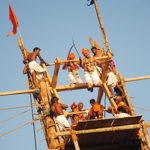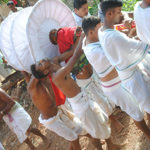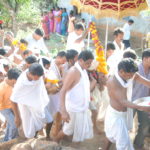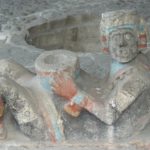
Anwesha Singbal
Shigmo is the celebration of the season of spring. There are some fascinating variations in the way Shigmo is celebrated in various parts of Goa. Unlike in North Goa, where Shigmo festivities begin on the full moon day of the Hindu month of Falgun, Canacona and most of the places in the South begin their festivities on the tenth day of Falgun. Let us explore some rare traditions and customs of Shigmo in Goa, that have ancient stories to tell.
While the floats and processions organized by Tourism department enthrall viewers in the main towns, the villagers of Goa still bestow their faith in these traditions that continue to exist here as part of the Shigmo festival.
On a full moon night of the month of Falgun, the village of Kudne located near Sanquelim in Bicholim taluka, goes mysteriously dark. In the obscurity of this darkness, some village men, designated as ‘gade’ run towards the crematorium and come back with parts of human bodies cremated there. This strange and macabre custom is one of faith and illusion, a tale that speaks about the unknown and the unseen.
“In some parts, this tradition is also a celebration of those brave souls who fought for the village against an enemy or who died to protect the village and its villagers from wild animals,” explains Rajendra Kerkar, a folklore expert and environmentalist from Keri in Sattari.
The ‘gade’ are considered to be ‘Bhutgan’ or ‘Pretgan’ (devotees of Lord Shiv Shankar) and are revered in an attempt to pacify evil spirits.
The Sal village of Bicholim is famous for the ‘Gadyachi Jatra’, a ritual where the gades’ bodies are said to be taken over by evil spirits. On the day of Holi Pournima, a mango tree trunk is decorated with mango leaves and erected near the Mahadev temple. On the following night, men dressed in white dhotis assemble at the sacred place called Mand. Soon a crowd (called Romat) assembles at the mand dancing to the beats of the dhol and taso. While the elderly sit nearby singing non-stop folk songs called ‘Naman’ to the beats of the dhol, the villagers invoke blessings from all the deities of the village and the gade move around the pole erected at the site of the mand.
In Sal village it is the Raut, Parab, Ghure and Mhale communities that are prominent in the gade festival. Earlier around 64 gades took part, which has now come down to 45. “It is believed that under a trance, these gade run in the direction of the hill where they are led into the forest by following a mysterious torch controlled by an evil spirit or devchar,” explains Kerkar, adding, “sometimes he lights the torch at the top of a tree, then suddenly it’s on the ground. This goes on for three nights.”
In Bali in Cuncolim, the tradition of gade is celebrated as ‘Shidiyo’. Here the main gado is tied to a long wooden pole (khaamb) that is fixed horizontally and moved sideways, from left to right and back, while the villagers seek his blessings. Here, young boys are also revered as gade and a needle and thread is stitched across their belly on the day of the festival.
Over to Canacona, where the famous ‘Shishyaranni’ festival is celebrated once every two years (it alternates with ‘Veera Mel’) on the occasion of Shigmotsav. During this festival, three gade are made to lie prone on the ground with their heads touching each other. A fire is then lit between their heads, which boils the pot of rice balancing on the three heads. A holy man (Bhagat) sits with his legs crossed in front of another Bhagat and hits a sword on the other’s head. The blood that oozes out is then mixed with the boiled rice and sprinkled around.
During this entire time, the Taranga (a decorated structure in the form of an umbrella with a wooden handle and colourful clothes over it which is considered holy by the villagers) remains erect, seemingly without any human support, and is kept in the outer hall of the temple.
Though there are some who challenge the authenticity and legitimacy of these rituals, the faith of the fervent villagers continues to flourish at the gade festivals in Goa.
Chorotsav in Sattari taluka
The Zharme and Karanzol villages of Sattari celebrate the age-old Chor-otsav festival which means the festival of thieves, during Shigmo. It is believed that in ancient times some men travelling from the Chorla Ghat and Kel Ghat were mistaken for thieves by the local villagers, and were beheaded. The Chorotsav festival is celebrated as an act of penance for this incident.
At the beginning of the Chorotsav the locals who consist of children, youth and elders dance in front of the temple to the beat of drums and other traditional musical instruments. Once the dance is over, the people gathered there can view the scene of the men symbolizing the ‘Chors’ (thieves) buried in the ground. In all eight men are buried in the ground, of which four have their heads buried with swords in their hands and the rest of their body above the ground. The other four men are buried with only their heads visible. According to the villagers these eight people are buried in this way to show four victims, with their heads separated from their bodies, as they were beheaded.
Gadyaanchi Zatra in Poinguinim
The festival of Gadyaanchi Zatra, which happens once in three years at Poinguinim, Canacona, is celebrated in the name of Shri Betal, the most feared and highly revered deity of Poinguinim and its neighbourhood. The story goes that Shri Betal conquered 12 kingdoms in Goa. In the 13th century, he conquered Poinguinim and annexed it to his 12 other kingdoms. The villagers requested him to reside peacefully in Poinguinim in return for various wishes that he asked for.
“It is believed that earlier human sacrifice took place, which was later given a humane face by killing cocks instead of human beings. Gadyanchi Zatra is the day when this sacrifice still takes place in Poinguinim,” explains folklore expert Pandurang Phaldesai from Canacona.
On the day of the zatra, the two ‘Tarangaa’, the ‘Satri’ and the ‘Pillkucho’ (bunch of peacock’s feathers) are brought ceremoniously to Poinguinim from Amona near Khotigao prior to the festival. Two massive tree trunks called ‘khaamb’ – around 13 to 14 meters high – are erected in front of the Shri Betal temple. A huge wooden spindle called the ‘Raatt’ with four arms is mounted on these ‘khaamb’. In the evening a metal hook is pierced into the back muscles of the four ‘gade’. The ‘gade’ climb the ‘khaamb’ wearing a turban and a dhoti. Each holds a sword in the right hand and a piece of cloth in the other. Each ‘gado’ is tied to the arm of the spindle. The spindle is then rotated. The ‘Mhaal gado’ (chief) then poses four questions to the crowd below, asking if the villagers from Poinguinim, Loliem and Kharegall have come and the final question asked is whether ‘everyone is happy’. After receiving a positive response the spindle is rotated and stopped, thus marking the end of the zatra.




























